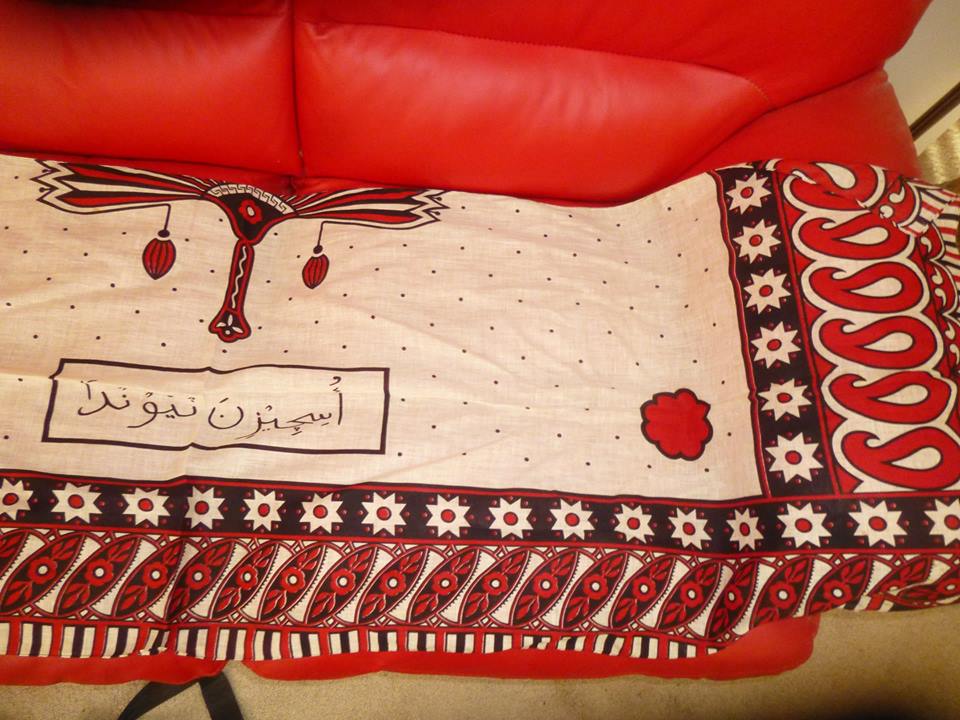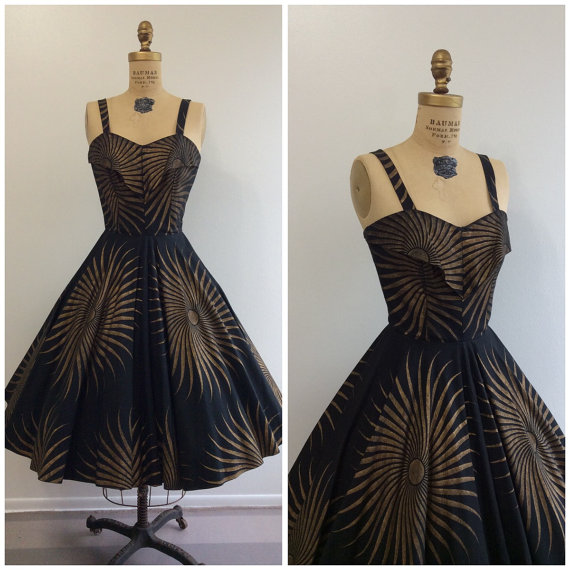
What a mystery this dress is! Like, seriously, this garment is a mish-mosh of cultures from all over the world, and the more I have researched the crazier this mystery has become.
Yatzitl Martel (the lovely lady in the photo above) posted it as feedback in a selling group, and I was immediately intrigued by the print. It looks like an East African khanga! You can tell because these native fabrics are printed in rectangular panels with thick borders. (They are also called lessos.) They often have a proverb and a picture of something in the middle. (Here is a picture of me wearing one the traditional way, as a wrap skirt.)
She was kind enough to let me use her photo and also sent me a picture of the label. It reads, "Nassau's Mademoiselle Bahamas / Bay Street, Nassau, Bahamas."

However, when I went to research the label.... I've found nothing but extant garments. They all have a similar resort wear vibe, and many of them are made of clearly African fabrics. Some look like wax prints and have West African motifs like cowrie shells.
This one worn by Yatzitl has the proverb below on it. I thought it was Arabic at first, but some fluently Arabic-speaking friends said it isn't. They suggested it may be Farsi/Persian. That is pretty strange for a khanga, since they're worn by peoples in East Africa, and Persian is not a language traditionally spoken there. What the heck is going on with this dress?!

All I've been able to find in my research is that the label continued for a long time, and there's even a store still in Nassau named Mademoiselle that I'm assuming is the same. I'm guessing that Mademoiselle in the Bahamas was a resortwear label much like Polly Hornburg in Bermuda who also used khangas and other ethnic fabrics in her shop. Apparently, many of the native prints were being printed in England for export, so designers could buy them from there and use them in their own designs. (Because at that point in time.... though the store was in the Bahamas, it was all "foreign" and "ethnic" and who could tell the difference?)
Sadly, I've pretty much reached only dead end pins and sale listings in researching "Mademoiselle." I was impressed with the beautiful use of print on the pieces I found, though, and I thought I'd share them with you so you can drool, too! This first one has an Arabic script on it too; how crazy is that?! WHAT?! Blowing my cultural mind.

Arabic (maybe?) dress

red and white dress


yellow bikini - for sale!

bird dress - for sale!


slim strapless & selvedge

shorts - for sale!

sunburst dress - for sale!
Sometimes we just don't have the information to solve vintage mysteries and we have to live with the ambiguity, hard as that is with such interesting pieces! Yazitl looks amazing in it, and I'm sure she loves it just the same!
I personally file the Nassau's Mademoiselle label under "1950s America is infatuated with the exoticism of native prints but can't differentiate between them.... but they're still really pretty and I love them." In fact, I'd love to own one someday!
While labels like this reflect the fact that many Westerners embraced native aesthetics without respecting the cultures and people they originated from, the pieces also show excellent use of print. They are appropriated textiles, but that doesn't diminish the fact that designers had to be creative in reshaping the rectangular prints of khangas and large scale motifs of wax prints to fit 1950s silhouettes. It still required creativity and skill that we can appreciate.
While we don't need to embrace the prejudice held by the fashion world at this time, we can "appropriate" these vintage pieces into our own modern world and revamp their meaning. Instead of ignorance, their multicultural elements can reflect our increasingly diverse world and identities, and we can pay homage to the cultures that created these motifs even if the original designers did not.
Have you ever heard of Mademoiselle? What are your thoughts on repurposing native fabrics like this? Do you have any idea what the heck is happening with a Persian khanga?
Read more about khangas in these posts:
My Church Khanga
1930s Zanzibar Dress
"God Is Good" Dress
Mystery of the Kanga Dress








Thanks for sharing this. I don't know if this has any connection, but here's a thought. Perhaps the mystery of Yatzitl's dress is based on a shared religion from a past connection. As a possibility for an example, I've read that the Sufi dimension of Islam is quite strong in East Africa (Tanzania, Somalia, etc.). However, in the 1500's Sufism had a strong base in Persia as well, with the rise of Esma'il (Ismail I), leader of the Safavid Empire. His empire lasted until almost the mid-1700's. What do you think?
ReplyDeleteHmmm, I'm not sure. I know sufis are still a minority in that area and I haven't heard of any speaking Persian in modern times, but it's the most reasonable connection I've encountered so far! A very good thought indeed!
Delete